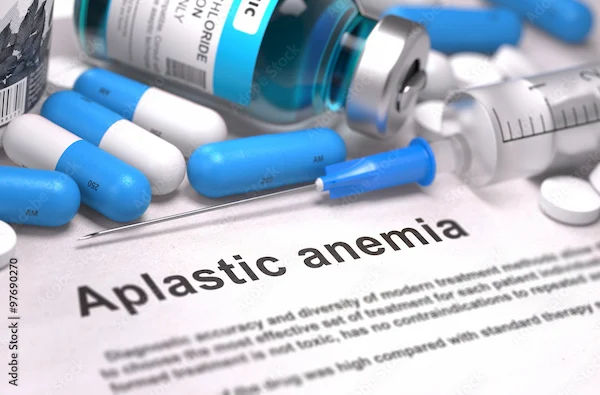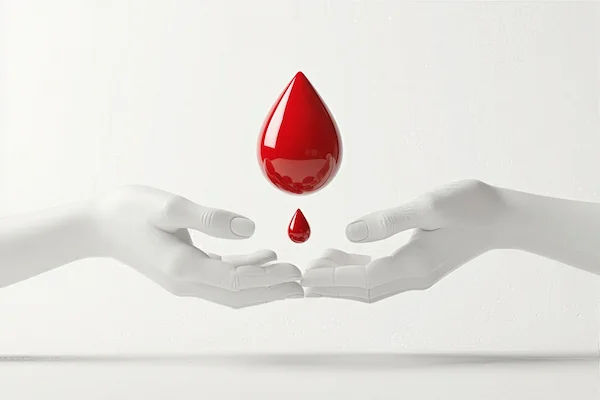A Comprehensive Guide on Thalassaemia Cure: Bone Marrow Transplant
Learn about how bone marrow transplant offers a potential cure for thalassaemia. Understand the procedure, benefits, risks, and types of bone marrow transplants.

Written by Dr.Sonia Bhatt
Last updated on 3rd Jul, 2025

Introduction
Thalassaemia is a hereditary blood disorder that occurs when the body doesn’t produce enough haemoglobin, an iron-rich protein in red blood cells that carries oxygen to all body parts. In simple words, when individuals have thalassaemia, their body makes less haemoglobin than normal. Individuals with thalassaemia may experience anaemia, fatigue and other complications that can impact their quality of life. The conditions vary in severity, with thalassaemia major being the most crucial form, requiring regular medical intervention. The global prevalence of thalassaemia has prompted significant research into curative treatments like bone marrow transplants.
What is a Bone Marrow Transplant?
A bone marrow transplant (BMT) is a procedure that replaces diseased bone marrow with healthy stem cells. It is also called a stem cell transplant. Cells can be used from the patient’s body (autologous transplant) or from a donor (allogenic transplant).
Stem cells are collected from the donor or patient. They are filtered, and the healthy stem cells are then transfused into the patient.
Bone marrow is a soft, spongy tissue inside the bones that produces blood cells, including red blood cells, white blood cells, and platelets. A healthy bone marrow is essential for maintaining normal blood function. In people with thalassaemia, bone marrow transplants offer the possibility of replacing defective marrow with healthy donor marrow to restore normal blood cell production. This intricate process involves sophisticated medical protocols and ongoing care to ensure success.
Understanding Thalassaemia
Thalassaemia is a genetic condition passed down through families, meaning it can be present from birth.
1. Types of Thalassaemia
There are two types of thalassaemia – Alpha and Beta. The severity of each type can vary from mild to serious.
1.Alpha Thalassaemia: This blood disorder reduces the production of haemoglobin, a protein that carries oxygen in the blood. It is an inherited condition that can cause mild to severe anaemia.
A few of the symptoms of alpha thalassaemia include:
Pale or yellow skin.
Poor appetite.
Enlarged spleen.
Bone problems.
Dark urine.
Tiredness.
2.Beta Thalassaemia: This is a hereditary blood disorder that causes the body to produce less haemoglobin. It can be caused by damaged or missing genes.
Some of the symptoms of beta thalassaemia include:
Anaemia, which can cause fatigue, weakness, and pale skin.
Bone pain.
Heart palpitations.
Shortness of breath, especially during exertion.
Bone deformities, especially in the long bones of the arms and legs.
Swollen abdomen.
2. Forms of Thalassaemia
Both alpha and beta thalassaemia include the following two forms:
1.Thalassaemia Major: It is a genetic condition that may cause severe anaemia. It is also known as Cooley’s anaemia.
A few symptoms include:
Jaundice.
Delayed puberty.
Enlarged spleen, liver, and heart.
2.Thalassaemia Minor: This genetic condition may cause mild or no symptoms. It occurs when someone inherits one faulty gene for haemoglobin production from one parent. Individuals with thalassaemia minor are also known as carriers of the condition.
Some of the symptoms include:
Smaller than usual red blood cells.
Mild anaemia can cause dizziness, fatigue, cramps, or shortness of breath.
3. Complications of Thalassaemia
Below are a few complications caused by thalassaemia:
Bone problems include bone deformities, fractures, and bone weakening.
Heart problems like heart failure, arrhythmias (irregular heartbeat), pulmonary hypertension and an enlarged heart.
Organ problems like damage to organs from lack of oxygen, enlarged spleen and liver, gallstones, kidney problems and liver disease.
Other complications may include endocrine problems, leg ulcers, hypercoagulability (increased risk of blood clots), and iron overload.
Consult Top Specialists for Personalised Treatment
Bone Marrow Transplant as a Cure for Thalassaemia
Bone marrow transplant involves transplanting healthy haematopoietic stem cells from a compatible donor into a thalassaemia patient. As mentioned before, normal blood cell production is enabled when these stem cells replace the defective marrow. This procedure helps address anaemia and prevent complications.
1. Types of Bone Marrow Transplants
The main types of bone marrow transplants are as mentioned below:
Autologous Transplant: In this transplant procedure, the patient uses their own blood-forming cells. The cells are collected, stored, and then given back after chemotherapy or radiation.
Allogenic Transplant: The patient uses blood-forming cells from a donor. The donor can be a family member, an unrelated adult, or a cord blood unit. The donor should share a close match with the patient’s human leukocyte antigens (HLAs).
Haploidentical Transplant: This uses partially matched donor cells, often from a parent or unrelated donor with close genetic markers.
2. Eligibility for Bone Marrow Transplant
The eligibility for bone marrow transplant may depend on:
The severity of the condition.
Age.
Availability of a matched donor.
Overall health status and absence of active infections.
The Procedure of Bone Marrow Transplant
A bone marrow transplant can be a complex procedure involving collecting stem cells, treating the patient’s body, and transfusing the stem cells back into the patient.
Preparation for bone marrow transplant includes the following steps:
Medical Evaluation: Comprehensive health assessment includes blood tests, organ function evaluation, and imaging studies.
Conditioning Therapy: It is administered before the transplant procedure and prepares the patient’s bone marrow to receive new stem cells by suppressing the immune system.
Donor Selection: Matching based on human leukocyte antigen (HLA) typing to minimise complications.
The transplant process is as follows:
Healthy stem cells are collected from the donor through peripheral blood stem cell collection or bone marrow extraction.
The cells are infused into the patient’s bloodstream through an intravenous (IV) line.
Stem cells mitigate to the bone marrow to initiate normal blood cell production.
Post-transplant care focuses on:
Regular monitoring for graft-versus-host disease (GVHD).
Immunosuppressive medications to prevent rejection.
Blood tests to track marrow recovery and ensure stable haemoglobin levels.
Nutritional support and infection prevention measures.
Benefits of Bone Marrow Transplant for Thalassaemia
Below are a few key benefits of opting for a bone marrow transplant for individuals with thalassaemia:
Potential lifelong cure for thalassaemia.
Reduced dependency on blood transfusions.
Improved development and growth in children.
Enhanced quality of life with minimal medical interventions post-transplant.
Early-stage transplants can yield better outcomes due to reduced iron overload and fewer complications. Also, success rates in developing countries have improved with better access to medical expertise and facilities.
Risks Associated with Bone Marrow Transplant
The immediate risks involved in a bone marrow transplant include:
Graft-versus-host disease (GVHD) may occur when donor cells attack the recipient’s tissues.
It can lead to organ damage due to chemotherapy toxicity.
Bleeding and allergic reactions can occur during the transfusion process.
Weakened immunity during the conditioning phase can cause infections.
The long-term side effects of the transplant can be:
Secondary cancers due to prolonged immunosuppressive therapy.
The psychological impact caused by extended hospitalisation and lifestyle adjustments.
Infertility due to conditioning therapy.
Chronic GVHD can affect the liver, skin and gastrointestinal tract.
Alternative Treatments for Thalassaemia
Alternate treatment options for thalassaemia are:
Regular blood transfusions can manage anaemia by replenishing healthy red blood cells.
Chelation therapy can help remove excess iron to prevent organ damage.
With gene therapy, experimental treatments aim to correct genetic mutations by inserting a functional haemoglobin gene.
CRISPR (clustered regularly interspaced short palindromic repeats) gene-editing technology presents a revolutionary step toward permanent cures.
Ongoing clinical trials show promising results in reducing or eliminating transfusion needs.
Conclusion
Bone marrow transplant is currently the only cure for thalassaemia. Ongoing research and advances in transplant techniques into gene therapy offer hope to affected individuals. Early diagnosis, timely intervention, and improved global access to transplant facilities can significantly improve patient outcomes.
Consult Top Haematologists
Consult Top Specialists for Personalised Treatment

Dr.sanchayan Mandal
Oncologist
17 Years • MBBS, DrNB( MEDICAL ONCOLOGY), DNB (RADIOTHERAPY),ECMO. PDCR. ASCO
Kolkata
Dr. Sanchayan Mandal Oncology Clinic, Kolkata

Dr. Sonal Paul
Haematologist
9 Years • MBBS, MD Pathology, DM Clinical Haematology
Kolkata
SATKRIT HEALTHCARE - A MULTISPECIALITY CLINIC, Kolkata

Dr. Thorana Prakash M
General Physician
2 Years • MBBS
Bengaluru
PRESTIGE SHANTHINIKETAN - SOCIETY CLINIC, Bengaluru

Dr. Sushith C
General Physician
2 Years • MBBS
Bengaluru
PRESTIGE SHANTHINIKETAN - SOCIETY CLINIC, Bengaluru
Dr Sumanth R
General Physician
2 Years • MBBS
Bengaluru
PRESTIGE SHANTHINIKETAN - SOCIETY CLINIC, Bengaluru
Consult Top Haematologists

Dr.sanchayan Mandal
Oncologist
17 Years • MBBS, DrNB( MEDICAL ONCOLOGY), DNB (RADIOTHERAPY),ECMO. PDCR. ASCO
Kolkata
Dr. Sanchayan Mandal Oncology Clinic, Kolkata

Dr. Sonal Paul
Haematologist
9 Years • MBBS, MD Pathology, DM Clinical Haematology
Kolkata
SATKRIT HEALTHCARE - A MULTISPECIALITY CLINIC, Kolkata

Dr. Thorana Prakash M
General Physician
2 Years • MBBS
Bengaluru
PRESTIGE SHANTHINIKETAN - SOCIETY CLINIC, Bengaluru

Dr. Sushith C
General Physician
2 Years • MBBS
Bengaluru
PRESTIGE SHANTHINIKETAN - SOCIETY CLINIC, Bengaluru
Dr Sumanth R
General Physician
2 Years • MBBS
Bengaluru
PRESTIGE SHANTHINIKETAN - SOCIETY CLINIC, Bengaluru
